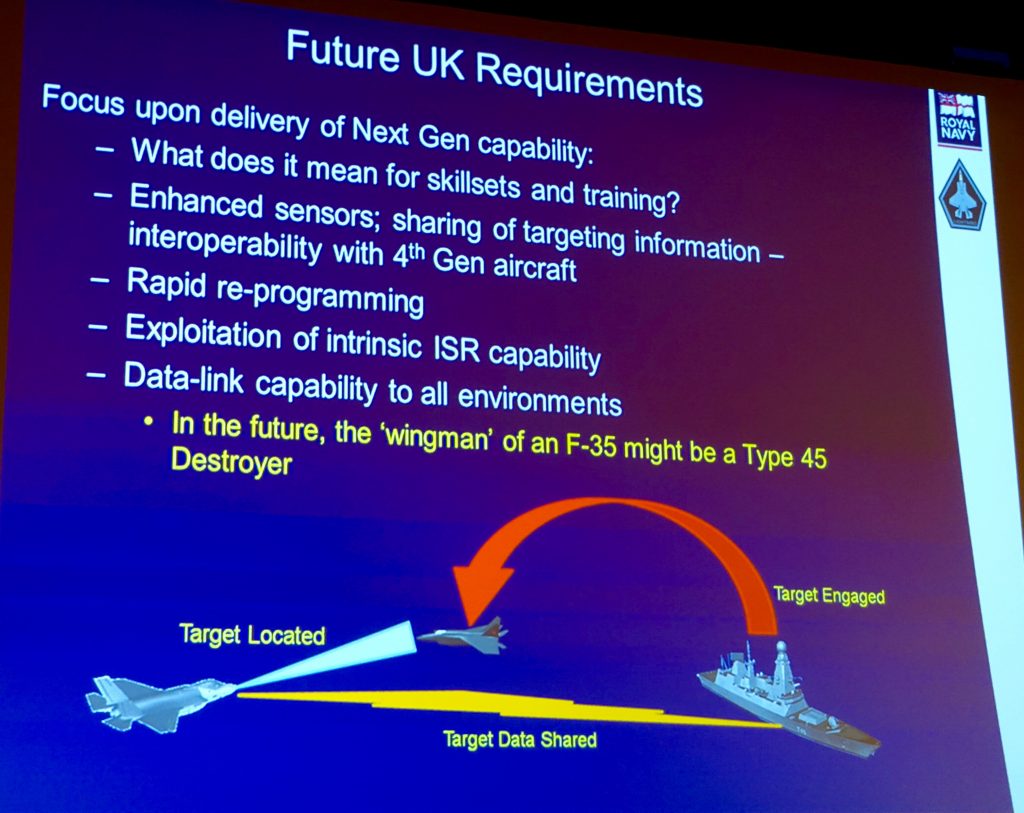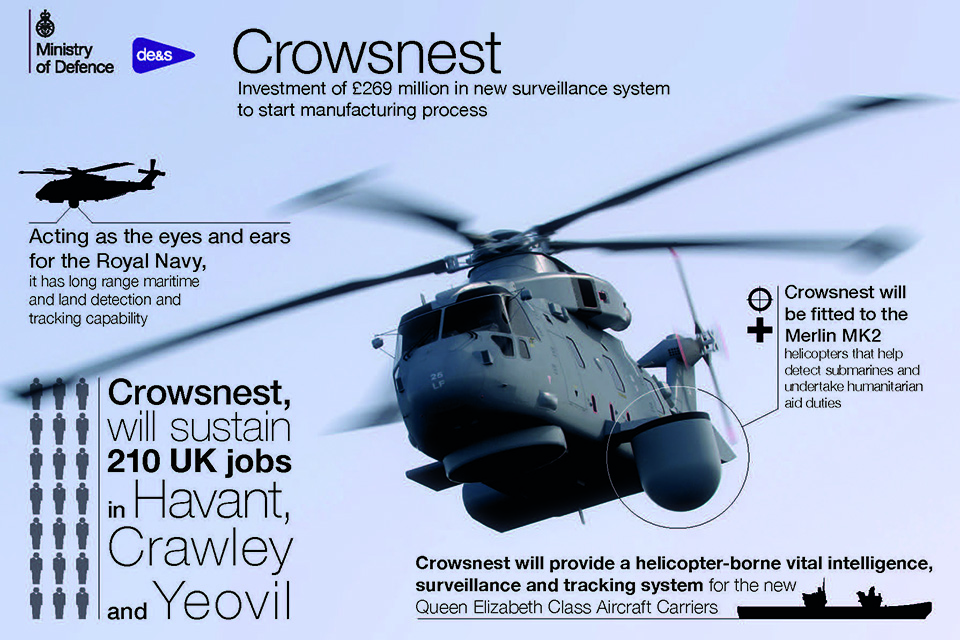2017-01-22 According to a Ministry of Defence story published on January 16, 2017, the UK is building a new helo based Crowsnest as part of the operational capability onboard their new class of carriers.
The deal with Lockheed Martin will see the start of manufacturing on the new Crowsnest system. It will act as the eyes and ears for the Royal Navy’s ships, providing long range air, maritime and land detection and tracking capability.
Minister for Defence Procurement Harriett Baldwin said:
- Crowsnest will provide a vital intelligence, surveillance and tracking system for our new Queen Elizabeth Class aircraft carriers, capable of detecting any potential threats at sea.
- Backed by our rising Defence budget, and our £178 billion equipment plan, Crowsnest will help keep our Armed Forces safe as they deploy in every ocean around the world for decades to come.
Crowsnest will be fitted to the Merlin Mk2 helicopters, which already perform a number of important roles for the Royal Navy, including detecting submarines and undertaking humanitarian aid duties – most recently in helping with part of the coordinated response to the migrant crisis in the Mediterranean.

Crowsnest is an important step in the ambitious carrier programme and will form an integral part of the Carrier Enabled Power Projection (CEPP) capability, which will deliver the two Queen Elizabeth aircraft carriers – the largest warships ever built for the Royal Navy – from which the UK’s new F-35 Lightning II jets will fly.
Under the deal with Lockheed Martin, Thales UK has been subcontracted to provide the system, work on which will sustain over 200 UK jobs in Crawley, Havant and Yeovil.
The Minister made the announcement on board the Type 45 Destroyer HMS Dragon at HMNB Portsmouth, where final preparations are underway for the arrival of the two 65,000 tonne carriers.
Improvements to the dockyard include:
- Reinforcing 276 metres of jetty with over 3,300 tonnes of new steel work
- Installation of new navigation lights in the harbour and Solent
- Delivery of huge new fenders and gangways to accommodate the giant ships
- Dredging of the harbour to accommodate the carriers’ vast size, including the removal of over three million cubic meters of clay, sand and gravel debris already cleared includes unexploded ordnance, cannons, and large anchors – some about 100 years old.
Lockheed Martin, as the prime contractor for Crowsnest, will integrate the selected Thales solution on to the Merlin Mk2 helicopter fleets. This work will be supported by Leonardo Helicopters, who will modify the fleet to fit Crowsnest. The contract also includes £9 million for initial provisioning of spares to support the Crowsnest system during training and operational deployment.
Chief Executive Officer of the MOD’s Defence Equipment and Support body, Tony Douglas, said:
- “Crowsnest will play a key role in protecting the Royal Navy’s future fleet acting as the eyes and ears for the new Queen Elizabeth Class aircraft carriers. This state-of-the-art project will demonstrate how we are providing world-leading, innovative equipment to our Armed Forces.”
- This contract will also sustain hundreds of UK jobs in the process, highlighting how the MOD, through DE&S, can create a positive and collaborative partnership with industry, benefitting both our Armed Forces and the UK economy.”
The Thales solution is an updated and improved version of the Cerberus tactical sensor suite, currently in service on the Sea King Mk7 helicopter.
The design is comprised of a single mechanically scanned radar head, which uses an innovative system to provide 360-degree visibility from the underside of the helicopter, which then folds up to the side of the aircraft when not in operation.
In his presentation in Australia last year, Captain Nick Walker discussed the coming of the new carrier and highlighted the role of the crowsnest as well.
The deck of the Queen Elizabeth carrier is 85% of the size (i.e. area) of a Nimitz class carrier; which can carry up to 36 F-35Bs along with a Merlin Crowsnests and a Merlin Mk2 ASW helo. Alternatively, the ship can be used in the projection of land forces from the sea in terms of Marines and helo insertion capabilities as well.

But it is the carrier strike focus which is definitional for the new carrier.
The ship has been designed from the ground up to support F-35B, in terms of weapons, C2, and ISR integration.
“We have also built from the ground up interoperability, and have worked closely with the USN and USMC with regard to this capability. And we are working on a broader approach to NATO interoperability as well.”
He provided an overview of the timing of the build out of the ship and the process of marrying it with the movement of the UK F-35Bs being prepared and trained in the United States to its permanent location in the UK at RAF Marham.
The initial carrier IOC is projected to be December 2020 with the fully integrated F-35 and carrier having full operational capability by 2025.
Much like the leadership of the Royal Australian Navy focused on in their presentations at the seminar, Walker emphasized new approaches to task forces as key part of their transformation approach.
Clearly, the UK is looking at the evolving impact of introducing carrier strike upon the overall change in the RAF and Royal Navy as well. And a key aspect of this transformation is working the evolving integration of fifth gen upon legacy capabilities.
Captain Walker highlighted the shift from a legacy mindset, which focused on thinking of maritime versus air environments to an integrated information dominance environment.
“A key cultural change is that we are looking at air and maritime as an integrated domain; and we are looking at the interaction among the environmental seams of our forces driven by a kill web approach and capability.”
A clear challenge is reworking C2.
“We need to shape a more mission order vice a directive Air Tasking Order approach to the use of an integrated air-maritime force.”
Putting the new carriers in play completely integrated with the F-35 will provide the foundation for shaping the way ahead for the UK power projection forces.
Put bluntly, shaping the way ahead will be defined by the operational experiences entailed in operating and deploying the new carrier strike force and leveraging that capability will be crucial in thinking through future procurement decisions as well.
“We are focused on being more platform agnostic; and ironically, the F-35 can be looked at as a new platform an keep in the old platform-centric approach but we are looking at it as lever of change for next generation thinking and capabilities.
“We are taking the kill web concept very seriously, and examining how best to shape the desired outcome from nodes in the operational force, rather than focusing on specialized platforms.
“How do we generate operational tasks to be delivered from the integrated force?”
“How do we bring the Typhoon which is a key air asset into the kill web?
“Rapid reprogramming of platforms is a crucial way ahead for sure.
“The ability to exploit the intrinsic ISR capability of the force, rather than simply relying on specialized ISR platforms is a key way ahead as well.
“The ability to deliver effect throughout the force with data-link capabilities such as in the future the wingman of an F-35 could well be the Type 45 destroyer”
In short, Captain Walker saw significant commonality in terms of the Australian rethink about the way ahead for their navy and how the UK was thinking about the transformation of its power projection capabilities.

